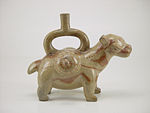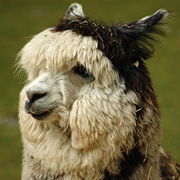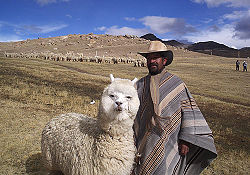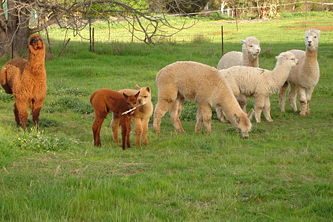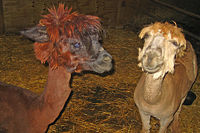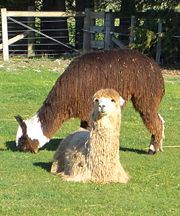Alpaca
2008/9 Schools Wikipedia Selection. Related subjects: Mammals
| Alpaca | ||||||||||||||
|---|---|---|---|---|---|---|---|---|---|---|---|---|---|---|
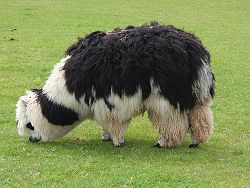 An unshorn Alpaca grazing
|
||||||||||||||
| Conservation status | ||||||||||||||
|
Domesticated
|
||||||||||||||
| Scientific classification | ||||||||||||||
|
||||||||||||||
| Binomial name | ||||||||||||||
| Vicugna pacos (Linnaeus, 1758) |
||||||||||||||
 Alpaca range
|
The Alpaca (Vicugna pacos) is a domesticated species of South American camelid. It resembles a small llama in superficial appearance.
Alpacas are kept in herds that graze on the level heights of the Andes of Ecuador, southern Peru, northern Bolivia, and northern Chile at an altitude of 3500 to 5000 meters above sea-level, throughout the year. Alpacas are considerably smaller than llamas, and unlike them are not used as beasts of burden but are valued only for their fibre. Alpaca fibre is used for making knitted and woven items, much as sheep's wool is. These items include blankets, sweaters, hats, gloves, scarves, a wide variety of textiles and ponchos in South America, and sweaters, socks, coats and bedding in other parts of the world. The fibre comes in more than 52 natural colors as classified in Peru, 12 as classified in Australia and 16 as classified in the United States. Alpacas and llamas differ in that alpacas have straight ears and llamas have banana-shaped ears. Aside from these differences, llamas are on average 1-2 feet taller and proportionally bigger than alpacas.
In the textile industry, "alpaca" primarily refers to the hair of Peruvian alpacas, but more broadly it refers to a style of fabric originally made from alpaca hair but now often made from similar fibers, such as mohair, Icelandic sheep wool, or even high-quality English wool. In trade, distinctions are made between alpacas and the several styles of mohair and luster.
Background
Alpacas have been domesticated for thousands of years. In fact, the Moche people of Northern Peru often used Alpaca images in their art. There are no wild alpacas. The closest living species are the wild Vicuña, also native to South America. Along with Camels and Llamas, the Alpaca are classified as Camelids. Larger than the wild Vicuña, the Alpaca is smaller than the other Camelid species.
Of the various Camelid species, the Alpaca and Vicuña are the most valuable fiber-bearing animals: the alpaca because of the quality and quantity of its fiber, and the vicuña because of the softness, fineness and quality of its coat. Alpacas are too small to be used as pack animals. Instead, they were bred exclusively for their fibre and meat
Alpaca meat was once considered a delicacy by Andean inhabitants. A recent resurgence in Alpaca meat was curtailed by a recent change to Peruvian law granting the Alpaca protected status. Today, it is illegal to slaughter or trade in Alpaca meat. Because of the high price commanded by Alpaca on the growing North American Alpaca market, illegal Alpaca smuggling has become a growing problem.
Alpacas and llamas can (and do) successfully cross-breed. The resulting offspring are called huarizo, which are valued for their unique fleece and often have gentle temperaments and are suitable for pets.
Behaviour
Alpacas are social herd animals that live in family groups consisting of a territorial alpha male, females and their young. They are gentle, elegant, inquisitive, intelligent and observant. As they are a prey animal, they are cautious and nervous if they feel threatened. They like having their own space and may not like an unfamiliar alpaca or human getting close, especially from behind. They warn the herd about intruders by making sharp, noisy inhalations that sound like a high pitch burro bray. The herd may attack smaller predators with their front feet, and can spit and kick. Due to the soft pads on their feet, the impact of a kick is not as dangerous as that of a hoofed animal, yet it still can give quite a bruise, and the pointed nails can inflict cuts.
Spitting
Not all alpacas spit, but all are capable. "Spit" is somewhat euphemistic. While occasionally the projectile contains only air and a little saliva, they also commonly bring up acidic stomach contents (generally a green grassy mix) and project it onto their chosen target. Spitting is mostly reserved for other alpacas, but an alpaca will occasionally spit at humans that, for example, take away food.
For alpacas, spitting results in what is called "sour mouth." Sour mouth is characterized by a loose-hanging lower lip and a gaping mouth. This is caused by the stomach acids and unpleasant taste of the contents as they pass out of the mouth.
Some alpacas will spit when looked at, others will never spit—their personalities are very individualized and there is no hard and fast rule in terms of social behaviour, although there is often a group leader, and a group trailer/runt that is picked on by others.
Physical contact
Once they know their owners and feel confident around them, alpacas may allow their backs and necks to be touched. They do not like being grabbed. Once socialized well, some alpacas tolerate being stroked or petted anywhere on their bodies, although many do not like their feet, lower legs, and especially their abdomen touched or handled. If an owner needs to catch an alpaca, the neck offers a good handle—holding the neck firmly between the arms is the best way to restrain the animal. Holding the neck from the rear with the animal's head under one's arm is also very effective.
Hygiene
To help alpacas control their internal parasites they have a communal dung pile, where they do not graze. Generally, males have much tidier, and fewer dung piles than females who tend to stand in a line and all go at once. One female approaches the dung pile and begins to urinate and/or defecate, and the rest of the herd often follows.
Because of their preference for using a dung pile, some alpacas have been successfully house-trained.
Sounds
Individuals vary, but Alpacas generally make a humming sound. Hums are often comfort noises, letting the other alpacas know they are present and content. The humming can take on many inflections and meanings, from questioning to a high-pitched, almost desperate, squealing when a mother is separated from her offspring.
Alpacas make other sounds as well as humming. When they are in danger, they make a high-pitched, shrieking whine. Some breeds are known to make a "wark" noise when excited, and they stand proud with their tails sticking out and their ears in a very alert position. Strange dogs—and even cats—can trigger this reaction. To signal friendly and/or submissive behaviour, alpacas "cluck," or "click" a sound possibly generated by suction on the soft palate, or possibly somehow in the nasal cavity. This is often accompanied by a flipping up of the tail over the back.
When males fight they also scream, a warbling bird-like cry, presumably intended to terrify the opponent. Fighting is to determine dominance, and therefore the right to mate the females in the herd, and it is triggered by testosterone. This is why males are often kept in separate paddocks—when two dominant males get together violent fights often occur. When males must be pastured together, it is wise to trim down the large fang-like teeth used in fights, called "fighting teeth". Although alpacas may try to bite each other they only have a bottom row of teeth, so damage is usually minimal. When fighting they will often tangle others necks and attempt to push each other around, but they settle down after a week, and agree to a winner and dominant male.
When alpacas breed, males make a similar noise called an "orgle". This is thought to possibly stimulate ovulation in the female. This can sound like a warbling or gargling noise in the back or the throat, possibly generated by movement of the tongue.
History of the scientific name
In the 18th and 19th centuries, the four South American camelid species were assigned scientific names. At that time, the alpaca was assumed to be descended from the llama, ignoring similarities in size, fleece and dentition between the alpaca and the vicuña. Classification was complicated by the fact that all four species of South American camelid can interbreed and produce fertile offspring. It was not until the advent of DNA technology that a more accurate classification was possible.
In 2001, the alpaca genus classification changed from Lama pacos to Vicugna pacos following the presentation of a paper on work by Dr Jane Wheeler et al on alpaca DNA to the Royal Society showing that the alpaca is descended from the vicuña, not the guanaco.
The relationship between alpacas and vicuñas was disputed for many years, but Wheeler's DNA work proved it. However, many academic sites have not caught up with this, so it is something well known to alpaca breeders who have read Hoffman's book, and to Royal Society members who have access to the current classification data, but not more widely known.
Poisonous to Alpacas
Many plants are poisonous to the Alpaca, including the bracken fern, fireweed, oleander, and some azaleas. In common with similar livestock, others include: Acorns, African rue, Agave, Amaryllis, Autumn Crocus, Bear Grass, Broom Snakeweed, Buckwheat, Ragweed, Buttercups, Calla lily, Orange tree, Carnations, beans from the Castor Oil plant, Cress and a great many others.
Fibre
Alpaca fleece is a light-weight, lustrous and silky natural fibre. While similar to sheep’s wool in that it is a natural fibre, it is warmer, not prickly, and bears no lanolin which makes it hypoallergenic . It is also soft and luxurious. In physical structure, alpaca fibre is somewhat akin to hair, being very glossy, but its softness and fineness enable the spinner to produce satisfactory yarn with comparative ease. It is hollow as well, which makes it a good insulator. The preparing, carding, spinning, weaving and finishing process of alpaca is very similar to the process used for wool.
Prices
The price for American alpacas can range from USD$100 for a desexed male or gelding to USD$500,000 for the highest of champions in the world, depending on breeding history, sex, and colour. It is possible to raise up to 10 alpacas per acre (25 alpacas per hectar) as they have a designated area for waste products and keep their eating area away from their waste area, which helps to avoid diseases. But this ratio differs from country to country and is highly dependent on the quality of pasture available (in Australia it is generally only possible to run one to three animals per acre due to drought). Fiber quality is the primary variant in the price achieved for alpaca wool; in Australia it is common to classify the fibre by the thickness of the individual hairs and by the amount of vegetable matter contained in the supplied shearings.
